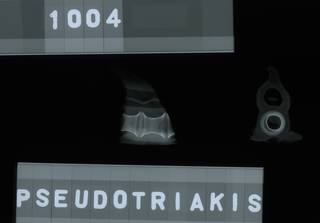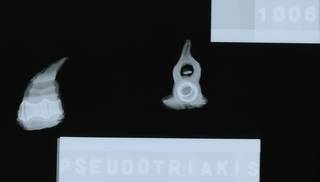Deep-Sea taxon details
Pseudotriakis microdon de Brito Capello, 1868
105805 (urn:lsid:marinespecies.org:taxname:105805)
accepted
Species
marine, brackish, fresh, terrestrial
Not documented
Description Found on the continental and insular slopes, occasionally wandering onto continental shelves. Scanty information on feeding...
Distribution The only records in our area are from N.Y. and N.J.; widespread in n. Atlantic
Description Found on the continental and insular slopes, occasionally wandering onto continental shelves. Scanty information on feeding habits but probably eats bony fishes, elasmobranchs and invertebrates. Ovoviviparous, with 2 to 4 young in a litter. Size at birth between 70 and 85 cm. There is reason to believe that this shark may have oophagy or uterine cannibalism, but this remains to be proven. [details]
Distribution The only records in our area are from N.Y. and N.J.; widespread in n. Atlantic
Distribution The only records in our area are from N.Y. and N.J.; widespread in n. Atlantic [details]
Froese, R. and D. Pauly. Editors. (2024). FishBase. Pseudotriakis microdon de Brito Capello, 1868. Accessed through: Glover, A.G.; Higgs, N.; Horton, T. (2024) World Register of Deep-Sea species (WoRDSS) at: https://www.marinespecies.org/DeepSea/aphia.php?p=taxdetails&id=105805 on 2024-04-16
Glover, A.G.; Higgs, N.; Horton, T. (2024). World Register of Deep-Sea species (WoRDSS). Pseudotriakis microdon de Brito Capello, 1868. Accessed at: https://www.marinespecies.org/deepsea/aphia.php?p=taxdetails&id=105805 on 2024-04-16
Date
action
by
context source (Deepsea)
Intergovernmental Oceanographic Commission (IOC) of UNESCO. The Ocean Biogeographic Information System (OBIS), available online at http://www.iobis.org/ [details]
basis of record van der Land, J.; Costello, M.J.; Zavodnik, D.; Santos, R.S.; Porteiro, F.M.; Bailly, N.; Eschmeyer, W.N.; Froese, R. (2001). Pisces, <B><I>in</I></B>: Costello, M.J. <i>et al.</i> (Ed.) (2001). <i>European register of marine species: a check-list of the marine species in Europe and a bibliography of guides to their identification. Collection Patrimoines Naturels,</i> 50: pp. 357-374 (look up in IMIS) [details]
additional source Robins, C. R.; Ray, G. C.; Douglass, J.; Freund, R. (1986). A field guide to Atlantic coast fishes of North America. <em>Houghton Mifflin Co. Boston.</em> 1-354. [details]
additional source King, C.M.; Roberts, C.D.; Bell, B.D.; Fordyce, R.E.; Nicoll, R.S.; Worthy, T.H.; Paulin, C.D.; Hitchmough, R.A.; Keyes, I.W.; Baker, A.N.; Stewart, A.L.; Hiller, N.; McDowall, R.M.; Holdaway, R.N.; McPhee, R.P.; Schwarzhans, W.W.; Tennyson, A.J.D.; Rust, S.; Macadie, I. (2009). Phylum Chordata: lancelets, fishes, amphibians, reptiles, birds, mammals. <em>in: Gordon, D.P. (Ed.) (2009). New Zealand inventory of biodiversity: 1. Kingdom Animalia: Radiata, Lophotrochozoa, Deuterostomia.</em> pp. 431-554. [details]
additional source Liu, J.Y. [Ruiyu] (ed.). (2008). Checklist of marine biota of China seas. <em>China Science Press.</em> 1267 pp. (look up in IMIS) [details] Available for editors
additional source Froese, R. & D. Pauly (Editors). (2023). FishBase. World Wide Web electronic publication. version (02/2023)., available online at https://www.fishbase.org [details]
basis of record van der Land, J.; Costello, M.J.; Zavodnik, D.; Santos, R.S.; Porteiro, F.M.; Bailly, N.; Eschmeyer, W.N.; Froese, R. (2001). Pisces, <B><I>in</I></B>: Costello, M.J. <i>et al.</i> (Ed.) (2001). <i>European register of marine species: a check-list of the marine species in Europe and a bibliography of guides to their identification. Collection Patrimoines Naturels,</i> 50: pp. 357-374 (look up in IMIS) [details]
additional source Robins, C. R.; Ray, G. C.; Douglass, J.; Freund, R. (1986). A field guide to Atlantic coast fishes of North America. <em>Houghton Mifflin Co. Boston.</em> 1-354. [details]
additional source King, C.M.; Roberts, C.D.; Bell, B.D.; Fordyce, R.E.; Nicoll, R.S.; Worthy, T.H.; Paulin, C.D.; Hitchmough, R.A.; Keyes, I.W.; Baker, A.N.; Stewart, A.L.; Hiller, N.; McDowall, R.M.; Holdaway, R.N.; McPhee, R.P.; Schwarzhans, W.W.; Tennyson, A.J.D.; Rust, S.; Macadie, I. (2009). Phylum Chordata: lancelets, fishes, amphibians, reptiles, birds, mammals. <em>in: Gordon, D.P. (Ed.) (2009). New Zealand inventory of biodiversity: 1. Kingdom Animalia: Radiata, Lophotrochozoa, Deuterostomia.</em> pp. 431-554. [details]
additional source Liu, J.Y. [Ruiyu] (ed.). (2008). Checklist of marine biota of China seas. <em>China Science Press.</em> 1267 pp. (look up in IMIS) [details] Available for editors
additional source Froese, R. & D. Pauly (Editors). (2023). FishBase. World Wide Web electronic publication. version (02/2023)., available online at https://www.fishbase.org [details]
 Present
Present  Inaccurate
Inaccurate  Introduced: alien
Introduced: alien  Containing type locality
Containing type locality
From other sources
Description Found on the continental and insular slopes, occasionally wandering onto continental shelves. Scanty information on feeding habits but probably eats bony fishes, elasmobranchs and invertebrates. Ovoviviparous, with 2 to 4 young in a litter. Size at birth between 70 and 85 cm. There is reason to believe that this shark may have oophagy or uterine cannibalism, but this remains to be proven. [details]Distribution The only records in our area are from N.Y. and N.J.; widespread in n. Atlantic [details]
Habitat benthic [details]
Habitat Known from seamounts and knolls [details]
| Language | Name | |
|---|---|---|
| English | false catsharkfalse cat shark | [details] |
| German | falscher Katzenhaifalsche Marderhai | [details] |
| Japanese | チヒロザメ | [details] |
| Lithuanian | mažadantis katryklis | [details] |
| Russian | мелкозубая акулаложнокунья акула | [details] |
| Spanish | Musolón de aleta larga | [details] |
| Ukrainian | Акула куняча несправжня | [details] |
To Barcode of Life (10 barcodes)
To Biodiversity Heritage Library (37 publications)
To Biological Information System for Marine Life (BISMaL)
To European Nucleotide Archive (ENA)
To FishBase
To FishBase images (Pseudotriakis microdon, Chinese Taipei, by The Fish Database of Taiwan)
To GenBank (23 nucleotides; 43 proteins)
To Global Biotic Interactions (GloBI)
To IUCN Red List (Least Concern)
To NMNH Extant Collection (Pseudotriakis microdon RAD110811-004)
To PESI
To ITIS
To Biodiversity Heritage Library (37 publications)
To Biological Information System for Marine Life (BISMaL)
To European Nucleotide Archive (ENA)
To FishBase
To FishBase images (Pseudotriakis microdon, Chinese Taipei, by The Fish Database of Taiwan)
To GenBank (23 nucleotides; 43 proteins)
To Global Biotic Interactions (GloBI)
To IUCN Red List (Least Concern)
To NMNH Extant Collection (Pseudotriakis microdon RAD110811-004)
To PESI
To ITIS










